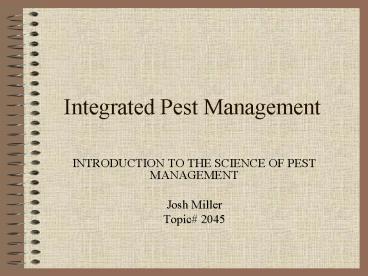Integrated Pest Management - PowerPoint PPT Presentation
1 / 19
Title:
Integrated Pest Management
Description:
Integrated Pest Management INTRODUCTION TO THE SCIENCE OF PEST MANAGEMENT Josh Miller Topic# 2045 Plant Health and Pests The condition of a plant as related to ... – PowerPoint PPT presentation
Number of Views:168
Avg rating:3.0/5.0
Title: Integrated Pest Management
1
Integrated Pest Management
- INTRODUCTION TO THE SCIENCE OF PEST MANAGEMENT
- Josh Miller
- Topic 2045
2
Plant Health and Pests
- The condition of a plant as related to disease
- Plant pest
- Anything that causes injury or loss to a plant
- Most are living organisms
- May kill the plant or make it worthless
3
How Pests Cause Losses
- Examples of pest losses
- Damage plant parts-eat holes in leaves, buds,
roots, fruit and other plant structures - Compete for space and nutrients weeds grow and
compete for water and nutrients with crop - Reduce quality of harvested crop pest may
contaminate the products of plants - Increased production cost control methods are
expensive and causes lower quality
4
Pest Control Tactics
- Integrated Pest Management (IPM)
- Using pest control methods that produce favorable
consequences - Two major procedures
- Scouting- observing crops for presence of pest
- Control- measures selected based on monitoring
information
5
Chemical Control Failure
- Rapidly expanded for 3 decades following 1945
- Mid 1970s scientist observed some pests were no
longer being effected - Pest have shown that they can adapt
6
Environmental Contamination
- Widespread use of large amounts causing damage to
the environment - Things that were being contaminated
- Soil
- Water
- Air
- Pesticide residues were found in food, feed and
organisms at all levels
7
Using IPM
- Key pests must be identified
- These are the pest that cause regular losses
- The presence of weeds or insects does not mean
that is is a key pest
8
Agroecosystems
- The ecosystem that is created in fields,
orchards, pastures and other places where crops
are grown - Can be used to benefit crops and reduce pest
9
Characteristics of Agroecosystems
- One species usually predominates
- There are numerous insects, birds and
microorganisms that live there - Humans intensively manipulate
- Plowing, seeding, mowing, fertilizing, using
pesticide alter system - Crop density has a positive effect
10
Agroecosystem Planning
- Pest problems can be reduced using selected crop
varieties - Some problems and be anticipated and avoided with
good planning - Host plant resistance
- Plants that are resistant to some pests
11
Thresholds
- Point at which an event or change occurs
- Injury threshold
- Based on the damage caused by a potential pest to
a crop to be classified as a pest - Some insects and live in a crop plant and cause
no damage - One weed or insect doesnt create crop injury
- Economic threshold
- Based on the returns to be gained from using a
pesticide
12
Benefits to Agriculture
- Major benefits of IPM
- Reduce pesticide cost
- Reduce application cost
- Less pesticide resistance
- Promote sustainable agriculture
- Reduce crop damage
- Stronger social and political support
13
Benefits to the Environment
- Major benefits of IPM
- Reduced contamination
- Fewer residues on food
- Improved human health
14
Safety with Pesticides
- Pesticide is a poison
- Classification of Pesticide
- Toxicity the degree of poison in a material
- Two categories
- General-use pesticide widely used by following
instructions on the label - Restricted-use pesticide higher toxicity than
general-use with a higher risk
15
Possible Hazards to People
- Carcinogen a pesticide suspected of causing
cancer - Pesticides enter human body through skin, mouth
and inhalation - 90 of all exposure occurs through the skin
16
Possible Hazards to People cont.
- Dermal Exposure
- Forearm 1.0
- Palm 1.3
- Ball of foot 1.6
- Abdomen 2.1
- Scalp 3.7
- Forehead 4.2
- Ear Canal 5.4
- Scrotal area 11.8
17
Possible Hazards to People cont.
- Protective equipment
- Gloves
- Boots
- Hats
- Overalls
- Goggles
- Face shields
- Respirator
18
Safety Procedures
- Use only approved pesticides in approved ways
- Read and follow instructions
- Use only when needed
- Use low toxicity pesticides
- Consider weather
- Properly use equipment
19
Safety Procedures cont.
- Properly dispose of empty containers
- Avoid contaminating the environment
- Protect from exposure
- Post warning signs
- Know emergency procedures































